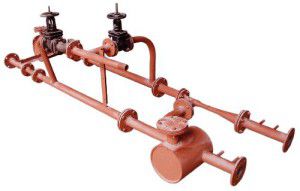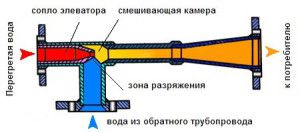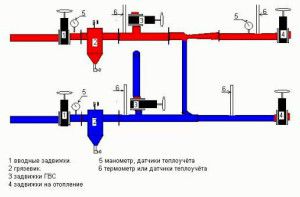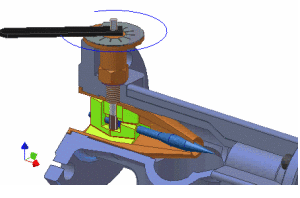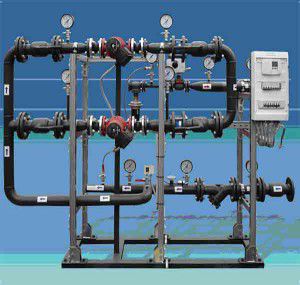Reducing heat loss is a major concern when planning district heating. For this, even at the stage of heating the coolant, special conditions are created for its transportation: increased pressure, maximum temperature. But in order for the distribution of hot water to drop to the required level, an elevator heating unit is installed: schemes, principles of operation and testing must strictly comply with the standards. Despite the fact that it is part of central heating, the average user should know how it works.
Elevator assembly designation
Even at the first stages of the design of central heating, engineers were faced with the problem of preserving thermal energy due to the length of the heating mains. To reduce heat loss, two main methods are used:
- Maximum thermal insulation of the pipe surface;
- Installation of elevator units in buildings.
The operating temperature in the external heating pipes is 150 or 130 degrees. It is forbidden to supply water to consumers at such a temperature. That is why an adjustable elevator heating unit was developed. It is designed to mix hot and cold coolant flows in order to optimize its temperature. In addition, pressure is also reduced to an acceptable level.
For normal operation, an automatic elevator heating unit is installed in a previously prepared room. For residential apartment buildings, this is the basement. Installation and further maintenance should only be carried out by specialists. Any violation of the operating mode can lead to emergency situations. Installation in private homes of such a heating element is impractical. This is due to the fact that boilers will not be able to provide proper temperature operation. Therefore, it is used only for creating branched heating systems with a large length of external heat pipes.
Based on the principle of operation of this elevator heating unit, it is possible to make a similar system for an autonomous system. But for this, two or three-way valves with thermostats are used.
The scheme of the elevator unit
At first glance, the principle of operation of the elevator unit of the heating system should be a rather complex system. However, in practice, a successful design was developed, which in its technical characteristics is similar to a three-way mixing valve.
Structurally, it consists of the following elements:
- Inlet pipe. A heat carrier with a high temperature under maximum pressure enters through it;
- Return pipe. It is necessary for connecting cooled water for further mixing with a stream of hot;
- Nozzle. A key element in the elevator circuit of a heating system. Hot water enters it under pressure and creates a vacuum in the receiving chamber. As a result, the cooled coolant mixes with the heated;
- Outlet pipe. It is connected to the distribution system of pipelines for further transportation of liquid to consumers.
In addition to it, the elevator unit of the central heating system should include additional elements. These include sumps, valves and sensors.The latter are required for installation, since with their help, the parameters of the entire system are monitored.
Having figured out what an elevator heating unit is, you need to learn more about its types and methods of adjusting operating modes.
After checking the operation of the elevator unit and the entire heating system, it is necessary to require an updated passport to the device. It indicates the initial characteristics and the actual ones after the verification checks.
Types of elevator heating units
This heating circuit of the elevator assembly does not disclose the temperature control mechanism. And this is the main way to optimize the consumption of thermal energy depending on external factors - outdoor temperature, the degree of insulation of the house, and so on. To do this, a special cone-shaped rod is installed in the nozzle. Gears provide its connection with the valve. By adjusting the position of the rod, the throughput of the nozzle changes.
Depending on the installed equipment, there are two types of adjustable elevator heating units:
- Manual way. The rotation of the valve is performed by the traditional method. In this case, the responsible employee must monitor the readings of manometers and system thermometers;
- Auto. A servo actuator is installed on the bolt pin, which is connected to temperature and pressure sensors. Depending on the established indicators, the rod moves.
A typical drawing of the elevator assembly should include not only the required elements, the operational characteristics of the system. And for this you need to make a calculation of the parameters. Such work is carried out only by specialized design organizations, since it requires consideration of all factors.
The installation of an adjustable elevator unit for heating in combination with a heat energy consumption meter will save up to 30% of the consumption of hot coolant.
Mounting Features and Verification
It should be noted immediately that the installation and verification of the operation of the elevator unit and the heating system is the prerogative of the representatives of the service company. Doing this is strictly forbidden to the residents of the house. However, knowledge of the elevator system layout of the central heating system is recommended.
When designing and installing, the characteristics of the incoming coolant are taken into account. Also taken into account the branching network in the house, the number of heating appliances and temperature conditions. Any automatic elevator unit for heating consists of two parts.
- Adjusting the flow rate of incoming hot water, as well as measuring its technical indicators - temperature and pressure;
- Directly the mixing unit itself.
The main characteristic is the mixing ratio. This is the ratio of the volumes of hot and cold water. This parameter is the result of accurate calculations. It cannot be a constant, as it depends on external factors. Installation must be carried out strictly according to the elevator assembly of the heating system. After that, fine tuning is done. To reduce the error, maximum load is recommended. Thus, the temperature of the water in the return pipe will be minimal. This is a prerequisite for the precise control of the automatic valve operation.
After a certain period of time, scheduled checks of the elevator unit and the heating system as a whole are necessary. The exact procedure depends on the specific scheme. However, you can draw up a general plan, which includes the following mandatory procedures:
- Checking the integrity of pipes, valves and appliances, as well as the conformity of their parameters to the passport data;
- Alignment of temperature and pressure sensors;
- Determination of pressure loss during the passage of the coolant through the nozzle;
- The calculation of the displacement coefficient. Even for the most accurate heating circuit of the elevator unit, equipment and pipelines wear out over time. This amendment must be taken into account when setting up.
After completing these tasks, the automatic central heating elevator assembly should be sealed to prevent tampering.
Do not use home-made elevator assembly schemes for central heating systems. They often do not take into account the most important characteristics, which can not only reduce work efficiency, but also cause an emergency.
Room requirements
In the vast majority of cases, the mixing units are mounted in the basement of the building. To perform its functions, it is necessary to take into account the characteristics of the room - seasonal changes in temperature and humidity.
There are a number of requirements for these indicators, the fulfillment of which is mandatory. This is especially true for the elevator nodes of the central heating system with installed automatic servos:
- The temperature in the room should not fall below 0 ° C;
- To prevent condensation on the surface of the pipes, an exhaust ventilation system is installed;
- For electrical appliances, a separate switchboard is necessarily mounted. It is recommended that an autonomous power supply be provided in the event of a power outage.
However, in fact it is rarely possible to meet the following rules. As a result, even for the most effective drawing of the elevator unit, its practical implementation can differ significantly. That is why alternative schemes for mixing coolant flows appeared.
In some new apartment buildings connected to central heating, there is no heating scheme with an elevator unit. For its installation, you need to contact the management company.
Other options for thermal nodes
Based on the basic principle of the elevator unit of the heating system, alternative methods have been developed to maintain the desired temperature level in the pipes for users. Their difference from the traditional scheme is the presence of a complex electronic control system.
The first thing that the developers of this unit drew attention to was the optimal consumption of hot water. Therefore, a heat meter must be installed on the inlet pipe. It makes it possible not only to see the amount of coolant received in the house system, but also can automatically calculate its cost and transfer data to the management company.
The installed pumps allow you to control the flow rate of the coolant through the pipes. This is necessary to reduce the error in mixing fluid flows in the nozzle. For this, temperature sensors are mounted on the inlet and return pipes. If the water heating level is less than the set value, the pump on the reverse stops its operation. To increase the volume of hot coolant, the corresponding pumping equipment is activated.
However, the disadvantages of such a system must be taken into account:
- Power Dependence. An emergency source of electricity can only work for a short time. To protect against voltage drop, the installation of a condensation rectifier is necessary;
- With increasing complexity of the system, the likelihood of its failure increases. It is enough for one of the sensors to fail - the optimal mixing parameters will change.
Despite these factors, the popularity of new systems is associated with their ease of use and significant savings in heating costs. That is why improved elevator units for the central heating system will be in demand.
As for the initial costs for the purchase of equipment and installation, these investments are returned in the form of saved money for heating for 3-5 years. But provided that the design and installation are professional and honest companies.
An example of integration of an elevator heating unit in conjunction with a heat meter:
